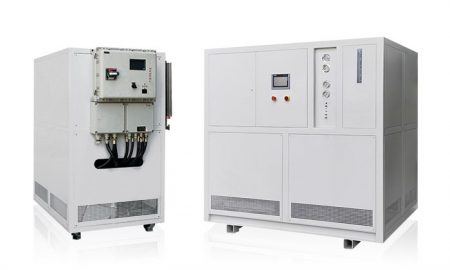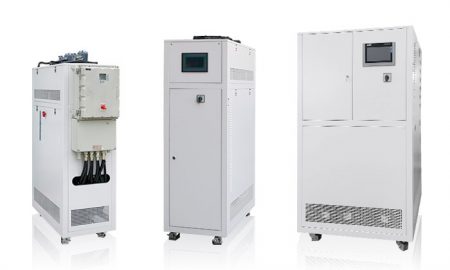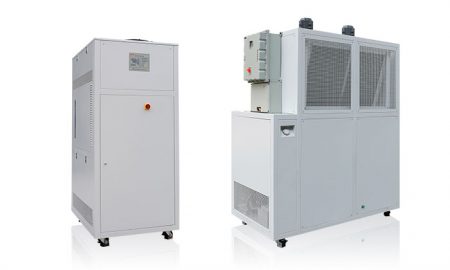Commonly Used Refrigerants in Chillers
1. Water
Water as a refrigerant is a low-cost solution that is completely non-toxic, readily available and environmentally friendly. However, choosing water as a refrigerant also has significant disadvantages, including:
· Ambient temperature can easily affect the efficiency of the cooling process
· Water can cause corrosion, damage refrigerant components and increase maintenance costs compared to some refrigerants.
2. R407C
The combination of hydrofluorocarbons difluoromethane (R32), pentafluoroethane (R125) and tetrafluoroethane (R134A) will provide heat, reduce flammability and reduce pressure, respectively. This refrigerant is recommended as the most suitable replacement for R-22 refrigerant systems, which will be phased out by 2020.

3. R404A
R404A should be considered if medium and low temperature refrigerants are required in the cooling process. This is a mixture of hydrocarbons that can be used in a variety of commercial settings, such as supermarkets and cold rooms.
4. R410A
For general purpose air conditioners, R410A is an anisotropic HFC mixture that can be used. It has no detrimental effect on the ozone layer and is gaining popularity as the R22 refrigerant is being phased out.
5. R22
R22, sometimes called R22 Freon or HCFC-22 Freon, has a boiling point of -40.7°C and is mainly used in low temperature systems. It is an environmental hazard and has been completely phased out due to its high Ozone Depletion Potential (ODP) = 0.05 and Global Warming Potential (GWP) = 1100.
6. R134A HFC
This is a hydrofluorocarbon (HFC) and halogenated alkane refrigerant commonly known as a defluorinating agent or Freon 134A. As a refrigerant, it has completely stable thermal properties, low toxicity, non-corrosiveness and non-flammability. Widely used in automotive air conditioning equipment and industrial air chiller equipment. Furthermore, R134A HFCs have the smallest ozone depletion potential and a global warming potential close to zero. Although considered relatively safe and environmentally friendly, the United States is planning to phase out its use.
7. R744 CO2
It is advantageous to use CO2 as a refrigerant because it is non-flammable and non-toxic. The downside is that a bulky system is required to handle the gas, and leaks can pose a huge safety hazard. Additionally, R744 C02 refrigerant can be very expensive to install and maintain.
8. R717 Ammonia
Ammonia (R717) is a refrigerant that belongs to the category of halogen-free chemicals. This is the most commonly used refrigerant in chillers. It has the highest level of heat absorption and is ideal for small portable chillers without the need for large cooling equipment. Another benefit of using ammonia as an air chiller refrigerant is its stable thermal performance. However, it should be handled with care as it has toxic effects on humans.
9. HCS
Hydrocarbons are another refrigerant used in domestic and industrial refrigeration air chillers. Common variants of hydrocarbon refrigerants are R600A (isobutylene) and R290 (propane). These refrigerant types are highly flammable and therefore require careful and special installation. As we all know, propane has no potential to destroy ozone, so it is suitable for environmentally friendly industrial air chillers.
Nous sommes un fabricant professionnel d'équipements de contrôle de la température et nous offrons des services personnalisés. nous consulter pour plus de détails !

Refroidisseurs à basse température
Plage de contrôle de la température : -150°C à -5°C
Application : Réacteurs divers, systèmes de distillation ou d'extraction, laboratoires, instituts de recherche, industries chimique, pharmaceutique, pétrochimique, biochimique, médicale, hospitalière, ateliers de R&D, tests de semi-conducteurs, aérospatiale, biologique et autres.
| Plage de température | Série -25°C ~ -5°C | Série -45°C ~ -10°C | Série -60°C ~ -10°C | Série -80°C ~ -30°C | Série -110°C ~ -50°C | Série -150°C ~ -110°C |
| Capacité de refroidissement | jusqu'à 360 kW | jusqu'à 360 kW | jusqu'à 360 kW | jusqu'à 270 kW | jusqu'à 180 kW | jusqu'à 11 kW |

Refroidisseurs à circulation
Temperature Control Range: -120°C to 30°C
Application : Réacteurs divers, systèmes de distillation ou d'extraction, laboratoires, instituts de recherche, industries chimique, pharmaceutique, pétrochimique, biochimique, médicale, hospitalière, ateliers de R&D, tests de semi-conducteurs, aérospatiale, biologique et autres.
| Plage de température | -25°C ~ 30°C series | -45°C ~ 30°C series | Série -60°C ~ -20°C | Série -80°C ~ -20°C | Série -120°C ~ -70°C |
| Capacité de refroidissement | jusqu'à 38 kW | jusqu'à 12 kW | jusqu'à 7,2 kW | jusqu'à 7,2 kW | jusqu'à 8,6 kW |

Normal Temperature Chillers
Plage de contrôle de la température : +5°C à +50°C
Application : Réacteurs divers, systèmes de distillation ou d'extraction, laboratoires, instituts de recherche, industries chimique, pharmaceutique, pétrochimique, biochimique, médicale, hospitalière, ateliers de R&D, tests de semi-conducteurs, aérospatiale, biologique et autres.
| Plage de température | -18°C ~ +30°C | +5°C ~ +50°C series |
| Capacité de refroidissement | jusqu'à 0,9 kW | jusqu'à 50 kW |
 LNEYA
LNEYA
 简体中文
简体中文


















































































